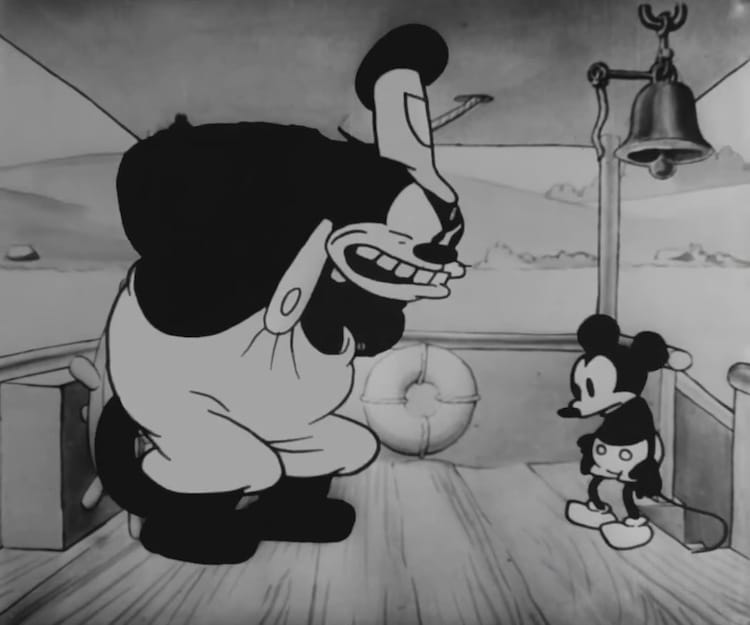
Clip of Mickey Mouse as he appeared in the 1928 cartoon “Steamboat Willie.” (Photo: Wikimedia Commons, Public domain)
Almost a century ago, one of the most iconic cartoon characters made his formal debut on the big screen. The 1928 animated short Steamboat Willie, one of the first cartoons with synchronized sound, featured an early version of Mickey Mouse in which he whistles to the tune of “Steamboat Bill” as he pilots a steam river sidewheeler. Although not the same as the Mickey Mouse most of us know today, the eight-minute film was the basis for the mascot that is synonymous with Walt Disney Studios. After several copyright extensions and nearly 96 years after its original release, Steamboat Willie has finally entered the United States public domain in 2024.
This means that it is only Mickey Mouse's appearance in the 1928 animated film that is in the public domain, and does not apply to his subsequent appearances in other works like Fantasia (1940). Even so, this allows creators to reuse the Steamboat Willie Mickey Mouse as long as it does not infringe on Disney's trademark of the character, which has no end. So what does this mean exactly? Jennifer Jenkins, director of the Duke Center for the Study of the Public Domain, and Sean Dudley shared a diagram that explains the dos and don'ts of this situation. In essence, “Steamboat Willie and the characters it depicts—which include both Mickey and Minnie Mouse—will be in the public domain” which means “anyone can share, adapt, or remix that material.”
However, Jenkins names two subsisting rights that people should avoid when using Steamboat Willie: “You cannot use new copyrightable versions of Mickey until those copyrights expire” and “You cannot use Mickey in a way that misleads consumers into thinking your work is produced or sponsored by Disney.” As long as creators make sure to adhere to these guidelines, they can reinterpret Mickey and Minnie Mouse from the 1928 film. “This is it. This is Mickey Mouse. This is exciting because it's kind of symbolic,” Jenkins says. “I kind of feel like the pipe on the steamboat, like expelling smoke. It's so exciting.”
Steamboat Willie was directed by Walt Disney and Ub Iwerks, and produced over three months with a small team of animators including Iwerks himself. Walt Disney used Pat Power's Cinephone system to sync the soundtrack to the film, and Disney even provided some of the short dialogue peppered in the cartoon. A review published in Variety in 1928 states: “The innovation of the animated film skyrocketed Disney and Mickey Mouse's fame. “Not the first animated cartoon to be synchronized with sound effects, but the first to attract favorable attention. This one represents a high order of cartoon ingenuity, cleverly combined with sound effect. The union brought forth laughs galore.”
Since Steamboat Willie entered the public domain, there was already an announcement of a Mickey Mouse horror film titled Mickey Mouse's Trap, due to release in March 2024. The movie emphasizes that it is not affiliated with Disney in any way, but depending on the content, Disney could still sue to protect its rights of the Mickey Mouse character. “We will, of course, continue to protect our rights in the more modern versions of Mickey Mouse and other works that remain subject to copyright, and we will work to safeguard against consumer confusion caused by unauthorized uses of Mickey and our other iconic characters,” said Disney.
After being safeguarded for decades, it will be exciting to see what this year and the ones that follow have in store for the Mickey Mouse character.
Disney's animated short Steamboat Willie—which is considered to be Mickey Mouse's formal debut—enters the public domain in 2024.

Original poster of the 1928 cartoon, “Steamboat Willie.” Mickey Mouse’s first animated short. (Photo: Walt Disney via Wikimedia Commons, Public domain)
This 8-minute film from 1928 was one of the first cartoons with synchronized sound.

The character Pete (left) and Mickey Mouse (right) as they appear in “Steamboat Willie” from 1928. (Photo: The Walt Disney Company via Wikimedia Commons, Public domain)
Jennifer Jenkins, director of the Duke Center for the Study of the Public Domain, made a mouse-shaped diagram titled Mickey Mouse: Trademark and Copyright Do and Don't.

A mouse-shaped diagram titled “Mickey Mouse: Trademark and Copyright Do and Don't” by Jennifer Jenkins, director of the Duke Center for the Study of the Public Domain, and Sean Dudley. (Photo: Jennifer Jenkins and Sean Dudley, CC BY 4.0)
Watch Steamboat Willie:
h/t: [NPR]
Related Articles:
Smithsonian Places 4.5 Million Historic Images Into the Public Domain
Circling the Zoetrope, a Victorian Animation Toy That Helped Shape the Future of Cinema






















































































